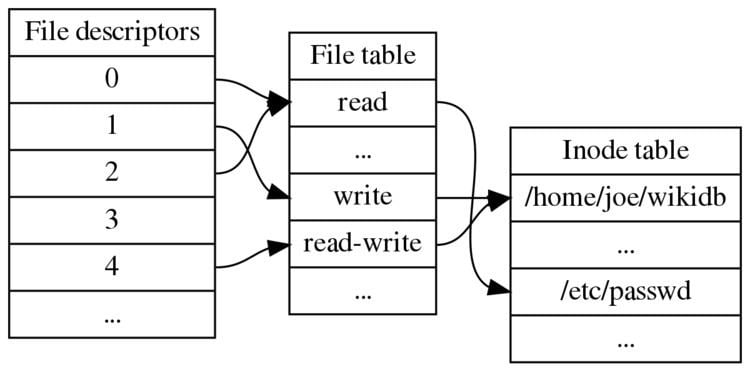 | ||
In Unix and related computer operating systems, a file descriptor (FD, less frequently fildes) is an abstract indicator (handle) used to access a file or other input/output resource, such as a pipe or network socket. File descriptors form part of the POSIX application programming interface. A file descriptor is a non-negative integer, generally represented in the C programming language as the type int (negative values being reserved to indicate "no value" or an error condition).
Contents
- Overview
- Operations on file descriptors
- Creating file descriptors
- Deriving file descriptors
- Operations on a single file descriptor
- Operations on multiple file descriptors
- Operations on the file descriptor table
- Operations that modify process state
- File locking
- Sockets
- Miscellaneous
- Upcoming operations
- File descriptors as capabilities
- References
Each Unix process (except perhaps a daemon) should expect to have three standard POSIX file descriptors, corresponding to the three standard streams:
Overview
In the traditional implementation of Unix, file descriptors index into a per-process file descriptor table maintained by the kernel, that in turn indexes into a system-wide table of files opened by all processes, called the file table. This table records the mode with which the file (or other resource) has been opened: for reading, writing, appending, and possibly other modes. It also indexes into a third table called the inode table that describes the actual underlying files. To perform input or output, the process passes the file descriptor to the kernel through a system call, and the kernel will access the file on behalf of the process. The process does not have direct access to the file or inode tables.
On Linux, the set of file descriptors open in a process can be accessed under the path /proc/PID/fd/, where PID is the process identifier.
In Unix-like systems, file descriptors can refer to any Unix file type named in a file system. As well as regular files, this includes directories, block and character devices (also called "special files"), Unix domain sockets, and named pipes. File descriptors can also refer to other objects that do not normally exist in the file system, such as anonymous pipes and network sockets.
The FILE data structure in the C standard I/O library usually includes a low level file descriptor for the object in question on Unix-like systems. The overall data structure provides additional abstraction and is instead known as a file handle.
Operations on file descriptors
The following lists typical operations on file descriptors on modern Unix-like systems. Most of these functions are declared in the <unistd.h> header, but some are in the
Creating file descriptors
Deriving file descriptors
Operations on a single file descriptor
Operations on multiple file descriptors
Operations on the file descriptor table
The fcntl() function is used to perform various operations on a file descriptor, depending on the command argument passed to it. There are commands to get and set attributes associated with a file descriptor, including F_GETFD, F_SETFD, F_GETFL and F_SETFL.
Operations that modify process state
File locking
Sockets
Miscellaneous
Upcoming operations
A series of new operations on file descriptors has been added to many modern Unix-like systems, as well as numerous C libraries, to be standardized in a future version of POSIX. The at suffix signifies that the function takes an additional first argument supplying a file descriptor from which relative paths are resolved, the forms lacking the at suffix thus becoming equivalent to passing a file descriptor corresponding to the current working directory. The purpose of these new operations is to defend against a certain class of TOCTTOU attacks.
File descriptors as capabilities
Unix file descriptors behave in many ways as capabilities. They can be passed between processes across Unix domain sockets using the sendmsg() system call. Note, however, that what is actually passed is a reference to an "open file description" that has mutable state (the file offset, and the file status and access flags). This complicates the secure use of file descriptors as capabilities, since when programs share access to the same open file description, they can interfere with each other's use of it by changing its offset or whether it is blocking or non-blocking, for example. In operating systems that are specifically designed as capability systems, there is very rarely any mutable state associated with a capability itself.
A Unix process' file descriptor table is an example of a C-list.
